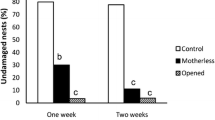Summary
Data are presented which document that females of the subsocial lace bug, Gargaphia solani lay eggs in the nests of conspecifics whenever the opportunity arises. Because of an inverse relationship between time invested in maternal care and fecundity, maternal behavior in G. solani is an ecologically expensive trait that is adaptive only in the face of heavy predation on eggs and nymphs. By facultatively utilizing the maternal defensive behavior of conspecifics, it is possible for egg donors to protect their progeny from predators without limiting fecundity. Whenever possible, females oviposit in recently established egg masses of conspecifics. While guarding their own eggs, egg recipients inadvertently protect the eggs of egg donors. Egg donors need not establish and guard their own masses as long as there are females with egg masses in the vicinity. Instead, egg donors are free to lay as many eggs as physiologically possible by avoiding long periods of maternal care.
Similar content being viewed by others
References
Bailey NS (1951) The Tingoides of New England and their biology. Entomol Am 31:1–140
Bertram BCR (1979) Ostriches recognise their own eggs and discard others. Anim Behav 28:278–286
Brown CR (1984) Laying eggs in a neighbor's nest: benefit and cost of colonial nesting in swallows. Science 224:518–519
Crozier R (1979) Genetics of sociality. In: Hermann HR (ed) Social insects, vol I. Academic, New York, pp 223–286
Custer CP, Hicks CH (1927) Nesting habits of some anthidiine bees. Biol Bull 52:258–277
Darling FF (1937) A herd of red deer. Oxford University Press, Oxford
Dhindsa MS (1981) Intraspecific nest parasitism in two species of Indian weaverbirds Ploceus benghalensis and P. manyar. Ibis 125:243–245
Drake CJ, Ruhoff FA (1965) Lacebugs of the world: a catalog (Hemiptera: Tingidae). Smithsonian Institution, US Nat Mus Bull 243, Washington, DC
Eickwort GC (1973) The biology of the European mason bee, Hoplitis anthocopoides (Hymenoptera: Megachilidae), in New York State. Search (Cornell Univ Agricult Exp Sta) 3
Eickwort GC (1975) Gregarious nesting of the mason bee, Hoplitis anthocopoides and the evolution of parasitism and sociality among megachilid bees. Evolution 29:142–150
Fabre JH (1914) The mason-bees. Translation by deMattos AT. Hodder and Stoughton, London
Galton F (1871) Gregariousness in cattle and men. Macmillan's Magazine, London 23:353
Hamilton WD (1964) The genetic evolution of social behavior, I and II. J Theor Biol 7:1–52
Hamilton WD (1971) Geometry for the selfish herd. J Theor Biol 31:295–311
Hamilton WD (1972) Altruism and related phenomena, mainly in social insects. Annu Rev Ecol Syst 3:193–232
Hamilton WD, Orians GH (1965) Evolution of brood parasitism in altricial birds. Condor 67:361–382
Hassell MP (1978) The dynamics of arthropod predator-prey systems. Princeton University Press, Princeton
Holmes WG, Sherman PW (1983) Kin recognition in animals. Am Sci 71:46–51
Kearns RS, Yamamoto RY (1981) Maternal behavior and alarm response in the eggplant lace bug. Gargaphia solani Heidemann (Tingidae: Heteroptera). Psyche 88:215–230
Lack D (1968) Ecological adaptations for breeding in birds. Methuen, London
Matthews RW (1965) The biology of Heriades carinata Cresson (Hymenoptera, Megachilidae). Contrib Am Entomol Inst 1, 3, 33
Michod RE (1982) The theory of kin selection. Annu Rev Ecol Syst 13:23–55
Nudds TD (1980) Canvasback tolerance of redhead parasitism: an observation and an hypothesis. Wilson Bull 92:414
Oster GF, Wilson EO (1978) Caste and ecology in the social insects. Princeton University Press, Princeton
Pitcher TJ (1973) The three-dimensional structure of schools in the minnow Phoxinus phoxinus (L.). Anim Behav 21:673–686
Raw A (1972) The biology of the solitary bee Osmia rufa (L.) (Megachilidae). Trans R Entomol Soc (Lond) 124:213–229
Sugden LG (1980) Parasitism of canvasback nests by redheads. J Field Ornithol 51:361–364
Tallamy DW (1982) Age specific maternal defense in Gargaphia solani (Hemiptera: Tingidae). Behav Ecol Sociobiol 11:7–11
Tallamy DW (1984) The ecology of insect parental care. Bioscience 34:20–24
Tallamy DW, Denno RF (1981) Maternal care in Gargaphia solani (Hemiptera: Tingidae). Anim Behav 29:771–778
Tallamy DW, Denno RF (1982) Life history trade-offs in Gargaphia solani: the cost of reproduction. Ecology 63:616–620
Treisman M (1975) Predation and the evolution of gregariousness II, an economic model for predator-prey interaction. Anim Behav 23:801; 825
Vine I (1971) Risk of visual detection and pursuit by a predator and the selective advantage of flocking behavior. J Theor Biol 30:405–422
Weatherhead PJ, Robertson RJ (1978) Intraspecific nest parasitism in the savannah sparrow. Auk 95:744
Weller MW (1959) Parasitic egg laying in the redhead (Aythya americana) and other North American Anatidae. Ecol Monogr 29:333–365
Williams CG (1966) Adaptation and natural selection. Princeton University Press, Princeton
Wilson EO (1975) Sociobiology: the new synthesis. Harvard University Press, Cambridge
Yom-Tov Y (1980) Intraspecific nest parasitism in birds. Biol Rev 55:93–108
Author information
Authors and Affiliations
Additional information
Published with the approval of the Director of the Delaware Agricultural Experiment Station as Miscellaneous Paper No. 1048, Contribution No. 544 of the Department of Entomology and Applied Ecology, University of Delaware, Newark, Delaware, USA
Rights and permissions
About this article
Cite this article
Tallamy, D.W. “Egg dumping” in lace bugs (Gargaphia solani, Hemiptera: Tingidae). Behav Ecol Sociobiol 17, 357–362 (1985). https://doi.org/10.1007/BF00293213
Received:
Accepted:
Issue Date:
DOI: https://doi.org/10.1007/BF00293213




